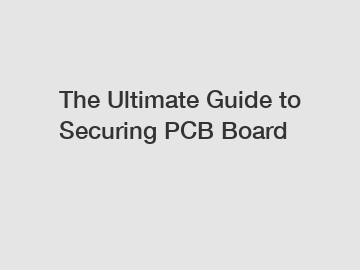The Ultimate Guide to Securing PCB Board
As technology continues to advance at a rapid pace, printed circuit boards (PCBs) have become the backbone of countless electronic devices, ranging from smartphones to automotive systems. With the growing complexity and functionality demands, ensuring the security of PCB boards has become a crucial aspect of electronics design and manufacturing. In this ultimate guide, we will delve into the world of PCB security, sharing invaluable tips and strategies to protect your designs from potential threats.
1. Understanding the Importance of PCB Security:
PCB security encompasses several critical aspects, including protecting intellectual property, preventing unauthorized access, mitigating counterfeit risks, and ensuring high reliability. As electronic devices become more interconnected, securing PCB boards becomes paramount, to safeguard both the end users and the reputation of the manufacturer.

2. Identifying Vulnerabilities and Threats:
To protect your PCB designs effectively, you must first understand the vulnerabilities and threats they face. This may include reverse engineering, data theft, unauthorized production, or tampering. By comprehending these risks, you can proactively enhance your security measures and design robust PCB boards accordingly.
3. Implementing Hardware Security Solutions:
Incorporating hardware security features into your PCB design serves as the first line of defense against potential threats. Techniques such as tamper detection circuits, secure microcontrollers, encryption mechanisms, and anti-tamper coatings help safeguard sensitive data and combat unauthorized modifications or reverse engineering attempts.
4. Ensuring Secure Data Communication:
In an interconnected world, secure data communication is essential to protect the integrity and confidentiality of sensitive information. Implementing secure communication protocols, such as encrypted communication channels and robust authentication mechanisms, ensures that data transmitted to and from the PCB remains secure.
5. Counterfeit Prevention and Mitigation:
The rise in counterfeit electronic components pose serious threats to PCB security, potentially compromising the functionality and safety of the end product. Thoroughly vetting suppliers, implementing secure supply chain practices, and utilizing anti-counterfeiting techniques like unique identifiers or holographic labels help mitigate this risk.
6. Robust Software Security Measures:
While hardware security is crucial, software security measures play an equally important role in securing PCB boards. Employing rigorous code reviews, implementing secure programming techniques, and utilizing encryption algorithms in software applications can significantly enhance the overall security of your PCB designs.
7. Physical Security Considerations:
Physical security should not be overlooked when it comes to PCBs. Implementing measures such as tamper-evident seals, secure storage, and secure disposal protocols ensure that your PCBs remain safe throughout their lifetime. Physical security measures are particularly important in power plants, communication systems, and defense applications.
8. Regular Security Audits and Updates:
To keep up with evolving threats, it is essential to conduct regular security audits and updates. Collaborate with security experts or third-party consultants to identify potential vulnerabilities in your PCB designs and implement necessary security patches or updates. Staying proactive in this regard helps maintain the highest level of security for your PCB boards.
Conclusion:
Securing PCB boards is crucial in today's technologically driven world, ensuring the protection of intellectual property, preventing data breaches, and maintaining the trust of customers. By implementing hardware and software security measures, addressing physical security considerations, and remaining vigilant through regular security audits, you empower your designs with the utmost degree of protection. Remember, investing in PCB security today not only safeguards your business but also ensures the continued success of your electronic products in an increasingly interconnected world.
Want more information on industrial control pcb , consumer electronics pcb , consumer electronics pcb ? Feel free to contact us.


